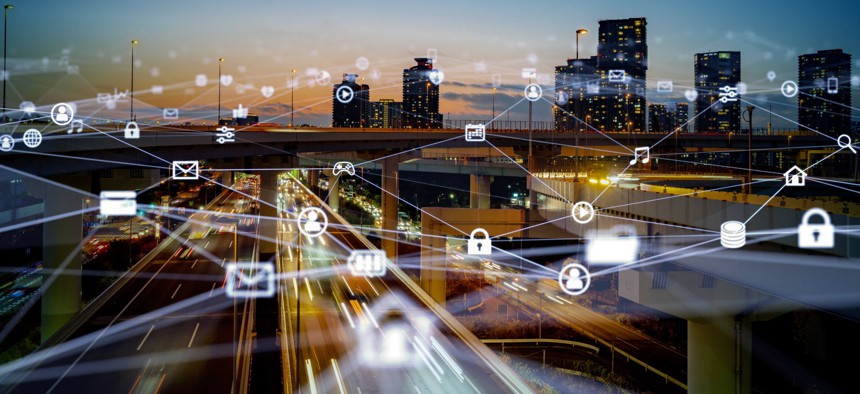How 5G and AI Are Creating an Architectural Revolution

Shutterstock

Connecting state and local government leaders
5G will transform IT from the bottom-up—and that means changes for security.
Driving down the road in a Tesla, you’re essentially sitting inside an edge compute node. In our last article, we began to illustrate the degree to which edge computing and the hybrid cloud are intrinsically linked to artificial intelligence and 5G. If we look at combat vehicles, hospital systems, or even coronavirus data collection, we can see this interconnection at play. In simplest terms, edge computing and cloud hosting offer the foundation for an architectural revolution that will allow 5G to power tech of the future, AI and automation included.
In this article, we will elaborate on the potential for 5G to transform IT from the bottom-up and, most importantly, outline what this revolution means for security.
The Digitization of Everyday Life
Many people think of 5G primarily with regard to consumer communications. Cell carriers have been touting the potential for 5G, with its higher bandwidth and faster speed, to deliver more content-rich services to your smart device, from 4K video to immersive augmented reality. But enterprise 5G is an enabler of another kind—one that can make machine-to-machine (M2M) communications possible. This is a far cry from 4G not just because of increased bandwidth, but because it shifts us from a closed, proprietary system to an open, virtualized one. The age of 5G is the age of dynamic, software-defined architecture.
Returning to the Tesla example, 5G makes it so the sensors on your car don’t just detect a tree on the side of the road, but are in communication with the data center and other sensors (or cars) in the field. For another example use case, let’s say the U.S. Forest Service is trying to see which trees in a national forest are diseased. If they deploy servers and sensors to that forest, the edge nodes that spread across its millions of acres must be able to communicate not just with the data center, but with each other. It’s 5G that allows the mass amounts of data collected in the forest to be connected to AI and thus turned into real-time insights. Put another way, AI is how you transform raw data into something useful. Many apps at the edge leverage AI and machine learning. 5G underpins them.
The interplay of these cutting-edge technologies represents the next phase in the evolution of computing. We went from mainframes to PCs, from PCs to client server architecture, and from client server architectures to the cloud. As our last article outlined, the hybrid cloud comes with a paradigm shift, ushering in an entirely new operating model with an unprecedented level of flexibility. By embedding AI into this architecture, networks and services can transform in real-time based on situations edge nodes are seeing. Thus, 5G will allow agencies to deliver more smart programming to the network and the tactical edge. It will also fuel the digitization of every aspect of life. We are seeing an explosion of applications that can be rapidly deployed on this new dynamic architecture for everything from disaster response to next-generation health care.
How to Secure Dynamic Architecture
The question, of course, is what 5G means for security. Because we are no longer working with a closed, proprietary system, we can no longer rely on an old-school model of simply encrypting data and thinking we are secure. It’s too limited and narrow. Compliance checklists, to be blunt, are outdated the day they are published and cannot keep up with the current threat environment. And yet, many organizations budget for compliance only. Every company that was breached in the last 15 years was compliant, though.
In a world of 5G, it’s not just data that must be secure, but AI algorithms and models. As such, 5G-enabled architecture requires a new security paradigm, too: a risk-based approach that considers the whole data lifecycle. Put another way, corporate security must shift from being compliance-based to risk-based. As mentioned in our last article, risk-based security should be built in from the beginning—encompassing design, procurement, the supply chain, the development process, and so on. Risk should be a dial for the application as it moves out to the edge just like power, bandwidth, storage, memory, and compute.
The Bottom Line
Artificial intelligence and 5G—two of tech’s biggest buzzwords—are closely tied to edge computing and the hybrid cloud. While the underlying architecture may be more complex in this new era, software simplifies it, allowing for the rapid development and distribution of new applications. But agencies must make sure they shift their entire paradigm, security posture included. As 5G allows agencies to deploy smarter programming to the edge and make sense of growing pools of data in real-time, their security must cover the entire data lifecycle and must adapt to ever-changing levels of risk.
Of course, agencies should still leverage what they already have from a security perspective. Too often, we protect from extraordinary, sophisticated outside threats while dropping the ball on basic cyber hygiene: simple things like resetting passwords and password complexity. Many customers have capabilities for dealing with common attacks, but fail to turn that technology on. In addition to this low-hanging fruit, though, agencies must ensure their approach is risk-based, as it’s far better suited for cloud-native, dynamic architectures, which come with a constantly evolving threat environment.
Steve Orrin is the Intel Federal chief technology officer and Cameron Chehreh is the Dell Federal chief technology officer.

NEXT STORY: What Democratic Control of Government Could Mean for Biden’s Tech Policies




